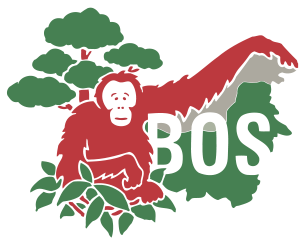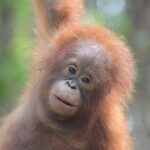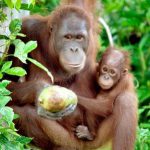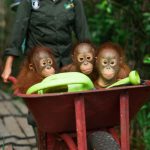Eating, wrestling, socialising
We are still overjoyed that we could return another seven orangutans to their true home in the Bornean rainforest. Back from the long journey, our release team revealed more details, which we can’t wait to share with you.
The first stage of the 180-kilometre release journey took several hours to complete by road. As per our Standard Operation Procedure, we stopped every two hours along the way to check on the orangutans in their transport cages. We purposefully made the stops in quiet areas to minimise the possibility of meeting local residents, in an effort to help curb the spread of COVID-19. We also made the conscious effort to depart from the Nyaru Menteng Orangutan Rehabilitation Centre at night, to reduce contact with others. As a result, our stops were uninterrupted throughout the journey.

Our staff checks on the orangutans regularly.
The road travel ended in Tumbang Hiran, a small town, where our team rested, just after midnight. Early the next morning, the team continued the journey on motorised longboats, or kelotok, along the Katingan River. About two hours later, they headed into the Bemban River and travelled upstream to the Bemban watershed, in a seven-hour ride.
Around 2 p.m., the team and the seven orangutans arrived at the release points located near the banks of the Bemban River, deep in the forest of the Bukit Baka Bukit Raya National Park. The orangutans were released one after another, with the post-release monitoring team standing by to take over monitoring of the orangutans as they adjusted to life in their new environment.
Here are the results of their observations on day one:
Suayap
Once we opened her cage, 22-year-old Suayap enthusiastically climbed up a nearby tree and ignored the activities going on around her as the release team prepared to open another cage.
Suayap, who was repatriated from Thailand in 2006, seemed to recognise the many types of natural food around her. She ate mahawai leaves, forest mangosteen and figs, and even termites. She was observed making efforts to approach Barlian and an unidentified orangutan, but did not interact with them.
As soon as the day began to turn dark, Suayap started building her evening nest up in a tree about 25 metres off the ground, not far from where she was released.
Unggang
Unggang climbed up a kapening tree after he was released. It took him quite a while to enjoy all the fruits around him. He was seen eating natural foods such as tunding ondang fruit, kempas cambium, and termites.
Unggang also built his night nest as soon as the day turned dark, up in a tree at around 30 metres off the ground and about 100 metres away from his release point.
Barlian
Unlike the other orangutans, Barlian needed more time to observe his new surroundings after his cage was opened. He walked along the ground for about ten metres before climbing up a tree.
Once Barlian was up in the trees, he approached Suayap, who we released before him. While the two were spending time together, an unidentified orangutan came by and Barlian wrestled with him. It seemed that the 20-hour journey had not exhausted the ten-year-old, as he managed to out-muscle the unidentified orangutan. He even tried to give chase when his challenger fled. In the end, Barlian opted to let the orangutan flee rather than keep up the chase.
Barlian also met with Unggang. At first, the two vocalised towards one another, but later became friendly and were seen eating together in a tapening tree. Our team members saw them consuming mahawai, lunuk, diwung, and pilang fruits.
For his night nest, Barlian chose to repair a used nest he found nearby, around 20 metres off the ground and about 100 metres from his release point.
Reren
Reren was released alongside Darryl, Amber, and Randy. At the start of observations, the four orangutans were seen interacting and foraging alongside one another. Reren was observed picking on Amber, but there was no aggressive behaviour between them.
Reren was active and ate a lot of forest food, including kondang and figs, wild ginger piths, and ferns. She built her nest close to Amber’s nest, around 250 metres away from the point where both of their cages were opened.
Amber
From the moment we opened her cage, Amber displayed aggressive behaviour, as though threatening to approach her observers. However, despite her threats, she ultimately chose to follow Reren. Not far from where she was released, Amber was observed eating kondang fruits, sangkuang fruits, and capilak leaves. She stayed by Reren and even built her night nest adjacent to her.

Amber, shortly after her release.
Darryl
After his cage was opened, Darryl briefly checked his surroundings before climbing up a nearby tree. Once he reached the treetop, he immediately started to fill his stomach, apparently hungry after the long journey. The PRM team watched Darryl eat kapilak leaves, sangkuang leaves, and termites.
He was also seen socialising, wrestling, and playing chase with Randy for about half an hour. Finally, Darryl decided to build his night nest nearby his release point.
Randy
Randy showed his displeasure at human presence when his cage was opened. With his hair raised on end, he rushed up a tree, but then later calmed down.
He seemed to be very content to be exploring his new environment and was seen eating a variety of natural foods, including kondang, figs, and gahung fruits. He wrestled Darryl before making his night nest at about 200 metres from his release point.
Looking at the PRM team’s observation notes, it is clear that these newly-released orangutans possess excellent foraging abilities in the forest. We are confident that all seven will lead happy and prosperous lives in their new home, the Bukit Baka Bukit Raya National Park.
Please help us give more rehabilitated orangutans the freedom they deserve. By donating to our tax appeal before 30 June, every dollar you give will have double the impact!




